Pantodonts, uintatheres and
xenungulates:
The first large herbivorous mammals
After larger terrestial animals had become extinct at the end
of the Cretaceous, pantodonts, uintatheres and xenungulates were
the first mammals to evolve to larger size. These animals were
once united in an order Amblypoda (meaning "blunt
foot"), but are today assigned to separate orders
Pantodonta, Dinocerata and Xenungulata.
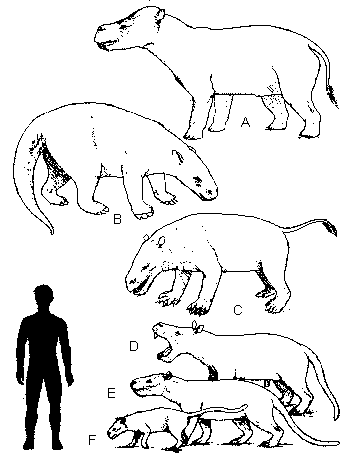 Pantodonts are
well known from the Paleocene of North America and Asia. Their
earliest representatives are still comparably small animals and
may have been omnivores. Surprisingly, one of these, Alcidedorbignya,
has recently turned up in the South American early Paleocene,
which proves that migrations between South America and Asia via
North America were possible at that time. Later pantodonts were
all clearly herbivorous animals. In comparison to other groups of
Paleocene mammals their skeleton is remarkably well known.
Pantodonts are
well known from the Paleocene of North America and Asia. Their
earliest representatives are still comparably small animals and
may have been omnivores. Surprisingly, one of these, Alcidedorbignya,
has recently turned up in the South American early Paleocene,
which proves that migrations between South America and Asia via
North America were possible at that time. Later pantodonts were
all clearly herbivorous animals. In comparison to other groups of
Paleocene mammals their skeleton is remarkably well known.
Paleocene pantodonts of Asia were relatively lightly built,
like Archaeolambda, which had claws and may have been
living in trees. North American pantodonts were generally larger.
Paleocene representatives include both generalized forms like Pantolambda
or Caenolambda and more specialized members like Titanoides
and Barylambda.
Barylambda was one of the largest Paleocene mammals
with an estimated mass of 650 kg. Its skeleton suggests that this
cumbersome animal was browsing by resting on its massive hind
limbs and its heavy tail, which allowed to raise the front of the
body and to reach higher branches. This adaptation is similar to
that of the extinct ground sloths like Megatherium.
Figure 1: Restorations of some pantodonts of the North
American Paleocene. A. Coryphodon.
B. Barylambda. C Titanoides
primaevus. D. Caenolambda.
E. Pantolambda cavirictus.
E. Pantolambda bathmodon.
After Simons (1960).
Titanoides, an animal of approximately 150 kg, had
saberlike upper canines, large front limbs and strong claws at
its feet. No mammal of today has a comparable anatomy of the
limbs, but several extinct groups like the Eocene to Pleistocene
chalicotheres show similar adaptations. Titanoides may
have utilized its claws to dig for food or to tear tough plants.
Figure 2: Skeleton of the pantodont Titanoides
primaevus from the Late Paleocene of North
America, showing the fearsome canines and unusual proportions of
this animal. Copyright by Kelly Taylor.
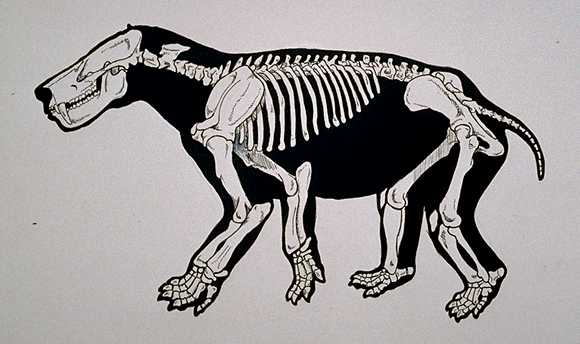
Figure 3: Life restoration of Titanoides
primaevus. With its claws the animal may
have laid bare underground roots and
tubers, which were then pulled up by the hooklike lower canines
and sliced off by the sabrelike upper canines. Copyright by Kelly Taylor.
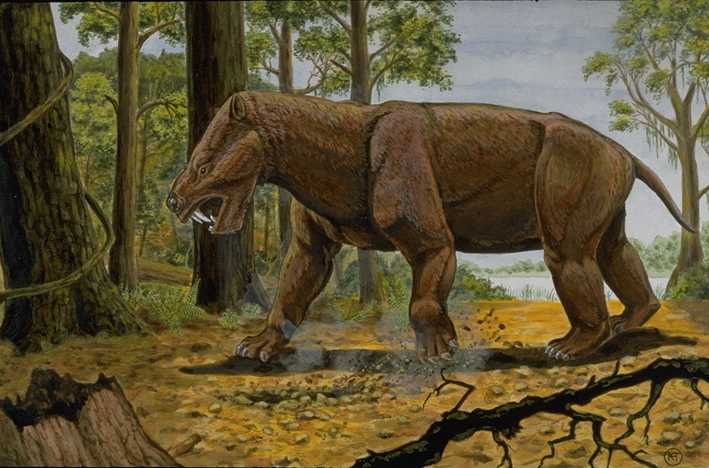
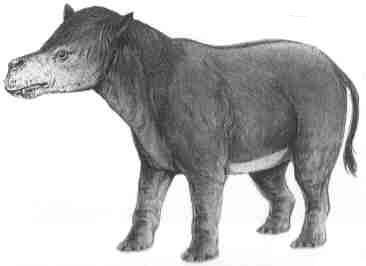 The most succesfull branch of pantodonts is
represented by Coryphodon and its descendants. Coryphodon
was a heavily built pantodont (up to 300 kg). Especially the
males had large canines similar to those of a hippo. Like this
animal Coryphodon may have been amphibious and may have
used its tusks to dig for plants. Coryphodon appeared
first in the latest Paleocene and occured all over the northern
hemisphere in the early Eocene. This longest lived branch of
pantodonts survived into the Oligocene of Asia, when they were
probably replaced by a group of rhinos with similar
specializations. Although pantodonts became extinct at that time
without leaving descendants, this archaic radiation had
anticipated the adaptations of several groups of mammals that did
not evolve until many millions of years later.
The most succesfull branch of pantodonts is
represented by Coryphodon and its descendants. Coryphodon
was a heavily built pantodont (up to 300 kg). Especially the
males had large canines similar to those of a hippo. Like this
animal Coryphodon may have been amphibious and may have
used its tusks to dig for plants. Coryphodon appeared
first in the latest Paleocene and occured all over the northern
hemisphere in the early Eocene. This longest lived branch of
pantodonts survived into the Oligocene of Asia, when they were
probably replaced by a group of rhinos with similar
specializations. Although pantodonts became extinct at that time
without leaving descendants, this archaic radiation had
anticipated the adaptations of several groups of mammals that did
not evolve until many millions of years later.
Figure 4: Life restoration of the pantodont Coryphodon,
a large hippo-like animal that probably spent much time in the
water. From Savage & Long (1986).
Uintatheres (order Dinocerata) are
best known to the public by grotesque Eocene forms like Uintatherium.
With an estimated body mass of up to 4500 kg, these were the
first really gigantic mammals. Eocene uintatheres sported several
blunt pairs of horns that were probably covered by skin. The
upper canines were enlarged in a saberlike form, and the lower
jaws had strong flanges to protect these teeth. These animals
were browsers and may have been ecologically similar to todays
rhinoceroces.
The first members of the order Dinocerata appear in the late
Paleocene of Asia (Prodinoceras) and North America (Probathyopsis).
The Asian and North American forms are closely related, so they
are important evidence for the relative dating of faunas of the
two continents. Fossil jaws of these early uintatheres occur in
two classes of different size and form, which are interpreted as
male (larger) and female (smaller) of the same species. Males of Probathyopsis
had a body mass of approximately 300 kg, similar to the weight of
the recent tapir Tapirus bairdi. Although this is small
in comparison to their gigantic descendants, Paleocene
uintatheres were among the largest mammals of their time. They
had already started to enlarge the upper canines and to develop
the corresponding flange of the lower jaw, both more pronounced
in the males, but they do not yet show the development of horns.
Their cheek teeth have the distinctive pattern that also
characterizes later members of the order, with two crests per
tooth, an adaptation to the efficient processing of plants.
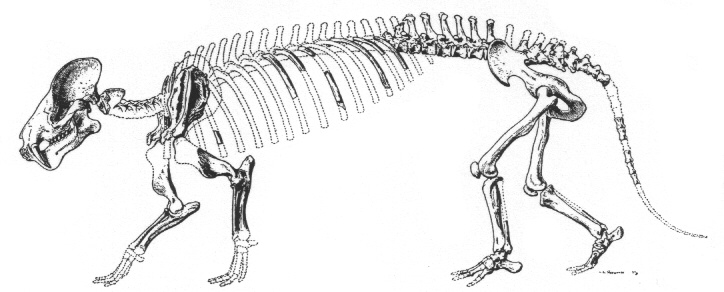
Figure 5: Reconstructed skeleton of the primitive
uintathere Prodinoceras martyr
(= P. plantigradum)
from the late Paleocene of Mongolia. Note the initial development
of enlarged canines and an associated lower jaw flange. Length
approximately 2.9 m. From Piveteau (1961), after Flerov (1952).
An enigmatic group of South American
mammals, the order Xenungulata, may be related to the
uintatheres. This poorly known order is mainly represented by the
middle Paleocene genus Carodnia (meaning 'thunder' in a
South American native language), the largest mammal yet
discovered in the Paleocene of South American. Carodnia
is known from fossils, including a partial skeleton, found in a
limestone quarry in Brazil, as well as from parts of the
dentition from Patagonia. Like the uintatheres, Carodnia
was heavily built for its time, had large canines and cheek teeth
with a crested pattern. This suggests that uintatheres and
xenungulates may have had a common ancestor, which migrated
either from Asia to South America or vice versa during the
Paleocene. There is some evidence that this ancestor was related
to small Asiatic mammals called anagalids, which in turn are
related to rodents and rabbits. Consequently, it has been
proposed that uintatheres could be considered as giant horned
bunnies - but this hypothesis still has to be demonstrated!
Possible South American descendants of the xenungulates are
the extinct pyrotheres. They are best represented by Oligocene Pyrotherium,
a remotely elephant-like but also poorly known animal.
<< Previous
article
Back to introduction
Much of this page is based on the articles on
Pantodonta and Dinocerata in Janis et al. (1998). Special thanks
to Kelly
Taylor for permission to use
the skeleton drawing and life restoration of Titanoides.
References:
Flerov, K. K. 1952: Novye Dinocerata iz
Mongolii (New Dinocerata from Mongolia). Doklady Akademii Nauk
SSSR 86, 1029-32
Janis, C. M. (ed.) 1998: Evolution of Tertiary
Mammals of North America. Cambridge University Press
Piveteau, J. (ed.) 1961: Traité de
Paléontologie. Tome VI: L'origine des mammifères et les aspects
fondamentaux de leur évolution
Savage, R. J. G. & Long, M. R. 1986: Mammal
evolution. An illustrated guide. British Museum (Natural History)
Simons, E. L. 1960: The Paleocene Pantodonta.
Transactions of the American Philosophical Society, new series,
50, 1-99
 Pantodonts are
well known from the Paleocene of North America and Asia. Their
earliest representatives are still comparably small animals and
may have been omnivores. Surprisingly, one of these, Alcidedorbignya,
has recently turned up in the South American early Paleocene,
which proves that migrations between South America and Asia via
North America were possible at that time. Later pantodonts were
all clearly herbivorous animals. In comparison to other groups of
Paleocene mammals their skeleton is remarkably well known.
Pantodonts are
well known from the Paleocene of North America and Asia. Their
earliest representatives are still comparably small animals and
may have been omnivores. Surprisingly, one of these, Alcidedorbignya,
has recently turned up in the South American early Paleocene,
which proves that migrations between South America and Asia via
North America were possible at that time. Later pantodonts were
all clearly herbivorous animals. In comparison to other groups of
Paleocene mammals their skeleton is remarkably well known.
 The most succesfull branch of pantodonts is
represented by Coryphodon and its descendants. Coryphodon
was a heavily built pantodont (up to 300 kg). Especially the
males had large canines similar to those of a hippo. Like this
animal Coryphodon may have been amphibious and may have
used its tusks to dig for plants. Coryphodon appeared
first in the latest Paleocene and occured all over the northern
hemisphere in the early Eocene. This longest lived branch of
pantodonts survived into the Oligocene of Asia, when they were
probably replaced by a group of rhinos with similar
specializations. Although pantodonts became extinct at that time
without leaving descendants, this archaic radiation had
anticipated the adaptations of several groups of mammals that did
not evolve until many millions of years later.
The most succesfull branch of pantodonts is
represented by Coryphodon and its descendants. Coryphodon
was a heavily built pantodont (up to 300 kg). Especially the
males had large canines similar to those of a hippo. Like this
animal Coryphodon may have been amphibious and may have
used its tusks to dig for plants. Coryphodon appeared
first in the latest Paleocene and occured all over the northern
hemisphere in the early Eocene. This longest lived branch of
pantodonts survived into the Oligocene of Asia, when they were
probably replaced by a group of rhinos with similar
specializations. Although pantodonts became extinct at that time
without leaving descendants, this archaic radiation had
anticipated the adaptations of several groups of mammals that did
not evolve until many millions of years later.